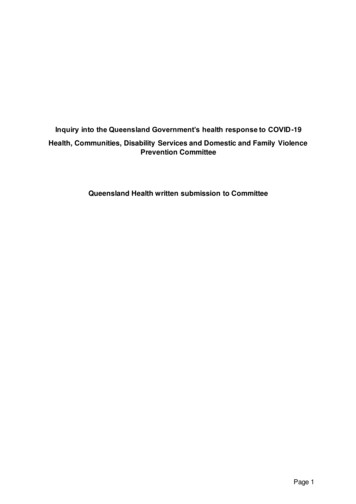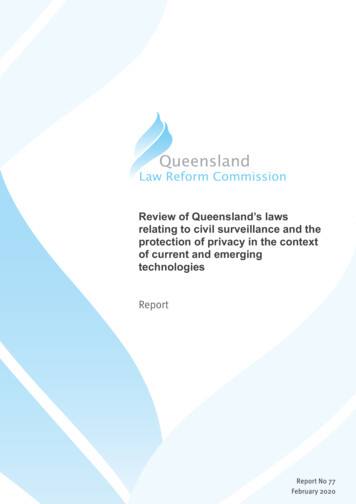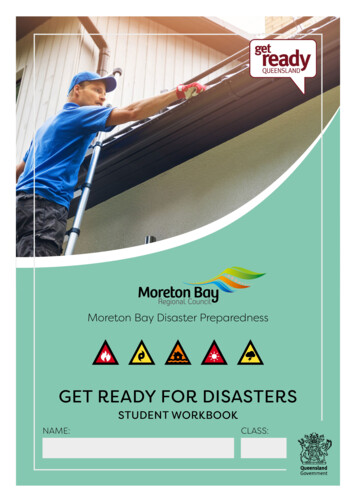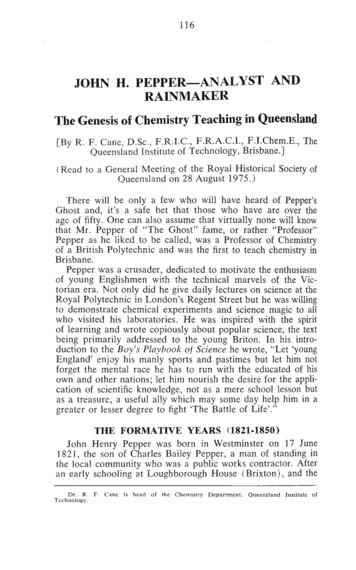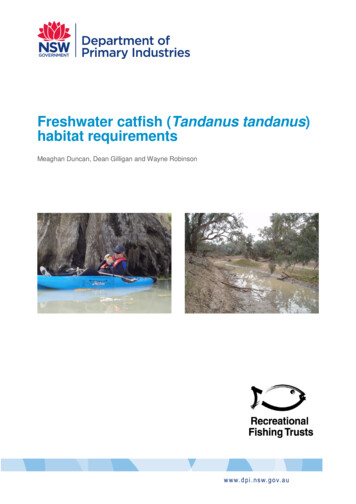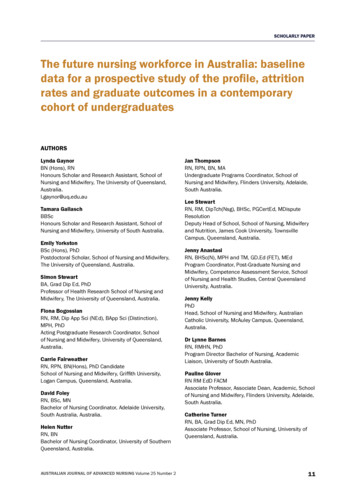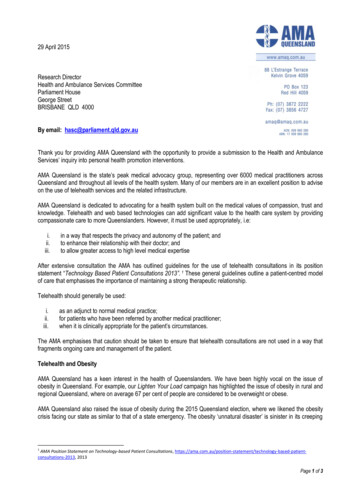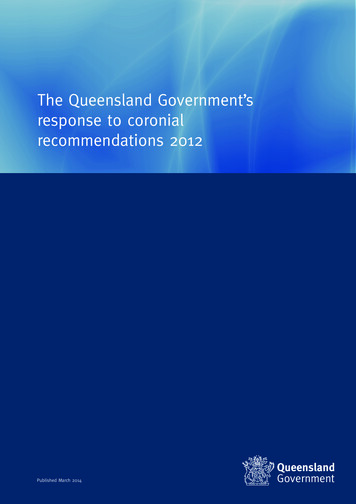
Transcription
The Queensland Government’sresponse to coronialrecommendations 2012Published March 2014
Published by the Queensland Government, March 2014, 50 Ann Street, Brisbane Qld 4000. The Queensland Governmentsupports and encourages the dissemination and exchange of information. However, copyright protects this document. TheState of Queensland has no objection to this document being reproduced for the purposes permitted under the CopyrightAct 1968, such as private study or research, but asserts its right to be recognised as the owner of the copyright and thatthis document remains unaltered. Reproduction for any other purpose by any means is prohibited without prior writtenpermission. Copyright enquiries about this document should be directed to the Department of Justice and Attorney-General.
PrefaceThe Queensland Government’s response to coronial recommendations2012 is a whole-of-government report responding to coronialrecommendations and comments directed towards the QueenslandGovernment during 2012. It also includes a response to anyrecommendation that remained under consideration in the QueenslandGovernment’s response to coronial recommendations 2011. This is thefifth annual report produced by the Department of Justice and AttorneyGeneral on behalf of the Government. The report aims to provide a publicresponse to all recommendations or comments made by Queenslandcoroners which have been directed to Queensland Government entities.While nothing will compensate for the loss of a loved one, it is hopedthat the families and friends of the people profiled in this report willreceive a measure of comfort from knowing that recommendations aimedat preventing similar tragic deaths have been considered by Governmentand in most cases, adopted.Many of the coronial recommendations profiled in this report have beenimplemented, or are in the process of being implemented. However, thefew recommendations in this report that are still under consideration byGovernment will be responded to in next year’s report.As the report is a consolidation of responses that have been authoredby the responsible Government agency, any questions about a particularresponse should be directed to the responsible agency named in thereport.Any other questions regarding the report can be directed to the LegalServices Coordination Unit of the Department of Justice and AttorneyGeneral either by emailing LSCUMailbox@justice.qld.gov.au or bytelephoning (07) 3008 8763.Queensland Government’s response to coronial recommendations 2012ii
Table of contentsInquest into the death of Robert Gary Mitchell. 3Inquest into the death of Lyji Vaggs. 5Inquest into the death of Roslyn Amelia Law. 7Inquest into the death of Brett Alexander Kevin McKenzie, Abigail Denise Ezzy,Nicholas James Nolan and Maxwell Ernest Thorley. 9Inquest into the death of Timothy John Wall.11Inquest into the death of Tony William Gates. 12Inquest into the death of a child referred to as ‘S’. 14Inquest into the death of Anthony Mark Perry. 23Inquest into the death of Antony Way, Tania Simpson, Kyla Rogers and Paul Rogers. 26Inquest into the death of Jack Wallace MacNicol. 29Inquest into the death of Ian Robinson, Natarsha Charlesworth, GeorginaHatzidimitriadis, Sang Won Park and Seongeun Choi. 31Inquest into the death of Patient A. 33Inquest into the death of Angus William Keith Ferguson. 34Inquest into the death of Adam Cartledge. 35Inquest into the death of Isabella Wren Diefenbach. 37Inquest into the death of Troy Jason Howse. 51Inquest into the death of Mia Davies. 52Inquest into the death of Jennifer Ann Boon. 55Inquest into the death of Joshua Jai Plumb. 58Inquest into the death of Preston Paudel. 63Inquest into the death of James Leon Short. 68Inquest into the death of Antonio Carmelo Galeano. 70Inquest into the death of Elizabeth Cardwell, Isabella Cardwell andGregory Sanderson. 85Inquest into the death of Julie Anne Bramble. 86Inquest into the death of Judith McNaught. 87Inquest into the death of Michael David Ley. 90Inquest into the death of Herbert John Mitchell. 95Recommendations profiled in the Queensland Government’s response to coronialrecommendations 2011. 98Inquest into the death of Graham Brown, Malcolm Mackenzie and Robert Wilson. 99Queensland Government’s response to coronial recommendations 20121
Table of contentsInquest into the death of a 15 month old child referred to as ‘C’. 102Inquest into the death of Saxon Phillip Bird. 103Inquest into the death of an unnamed prisoner. 104Inquest into the death of Gregory McClellan, Yan Sun, Shengqi Chen andDominic Chen. 105Inquest into the death of Graham Robert Tait. 106Inquest into the death of Tracey Lee Inglis. 107Queensland Government’s response to coronial recommendations 20122
Inquest into the death of Robert Gary MitchellOn 9 July 2008, Robert Mitchell died in his cell at the Arthur Gorrie Correctional Centrehaving hanged himself from exposed bars above the door.The then-State Coroner, Michael Barnes, delivered his findings on 20 January 2012.Concluding comments, page 6Once again the primary risk factor highlighted by this case is one that hasbeen well known and subject of public debate and coronial comment forat least 20 years, namely the existence of hanging points in prison cells.As this case demonstrates, it is impossible to identify with precisionthose prisoners who might take their own lives. Of the 552 suicides thathave occurred in Australian jails since 1980, 90% have been hangings.Therefore, if jail suicides are to be minimised, it is essential all prisonersare kept in cells that do not have hanging points.I accept the submission Queensland Corrective Services is committedto a policy of replacing unsafe cells with suicide resistant facilities asfunds allow. I also accept that many unsafe cells have been closedor refurbished. Nevertheless, hundreds of prisoners remain housed incells with exposed hanging points, despite the Royal Commission intoAboriginal Deaths in Custody recommending 20 years ago that this notoccur and the State Government’s public commitment to implementingthe recommendation. As a result, a further five prisoners have hungthemselves in Queensland correctional centres since Mr Mitchell’s death.Response and actionAgreed and implementation is partially completeResponsible agency: Department of Justice and Attorney-General (the machinery ofgovernment arrangements in November 2013 saw Queensland Corrective Servicestransition from the Department of Community Safety to the Department of Justice andAttorney-General)Queensland Corrective Services is committed to a policy of replacing unsafe cells withsuicide resistant facilities, and is progressively reducing the number of hanging pointsin Queensland Correctional Centres with the construction of new and refurbishedCorrectional Centres.Funding of 19.5 million is provided in 2013-14 to continue the 33 million cell upgradeprogram to modify cells in the Arthur Gorrie Correctional Centre. Work commenced onsite in January 2013 with completion expected in the 2014 calendar year.Suicide reduction measures are in place in 90% of all secure cells.Queensland Government’s response to coronial recommendations 20123
Inquest into the death of Robert Gary MitchellThe first stage of the Arthur Gorrie Correctional Centre cell upgrade program willprovide a further 112 suicide resistant cells increasing the total percentage to 93%in the 2014 calendar year.Following completion of stage one at the Arthur Gorrie Correctional Centre,268 cells at the Arthur Gorrie Correctional Centre and 138 cells at TownsvilleCorrectional Centre will remain to be modified.Queensland Government’s response to coronial recommendations 20124
Inquest into the death of Lyji VaggsLyji Vaggs died on 15 April 2010 at the Townsville Hospital from hypoxic brain injury.The brain injury was sustained at the Townsville Acute Mental Health Unit two daysbefore his death when he was restrained in a prone position for a prolonged periodby hospital security officers and nursing staff. During this time he was administeredOlanzepine and Midazalam.The then-State Coroner, Michael Barnes, delivered his findings on 21 February 2012.Recommendation 1 - review of approved restraintsI recommend the Director of Mental Health give further consideration towhether flexible plastic wrist ties or hinged handcuffs should be approvedfor use in restraining violent mental health patients.Response and actionAgreed and implementation is completeResponsible agency: Queensland HealthThe Director of Mental Health has given further consideration to the use of flexibleplastic wrist ties and/or hinged handcuffs. The Director of Mental Health is comfortableclinically with the existing legislative approval for the use of wrist to waist restraints asa first line option of mechanical restraint with scope to approve the use of alternativemechanical restraint devices as a clinical scenario dictates.Under the Mental Health Act 2000, the Director of Mental Health is responsible for theoversight of all episodes of mechanical restraint within authorised mental health services.Chapter 4A, Part 1 of the Mental Health Act 2000 states that a mechanical applianceused for mechanical restraint must be approved by the Director of Mental Health andincludes a restriction of the authorisation time period for mechanical restraints (threehours) to ensure regular clinical review of the utility of the restraints.Chapter 13 of the Safety and Security in Authorised Mental Health Services of the MentalHealth Act 2000 Resource Guide (2013) contains a definition of mechanical restraint,approved mechanical appliances, authorisation process, legislative principles, requirementfor authorisation and reporting requirements.Chapter 13 of the Resource Guide also provides that if the Clinical Director of a MentalHealth Service considers an alternative mechanical appliance needs to be applied toprevent injury to a patient or someone else, the Clinical Director must immediatelycontact the Director of Mental Health to seek approval to use the alternative appliance.The Director of Mental Health will then determine whether the alternative mechanicalappliance is approved, having regard to the individual circumstances of the case. Suchapproval will only apply to that individual for the period specified by the Director ofMental Health, based on the clinical information provided.Queensland Government’s response to coronial recommendations 20125
Inquest into the death of Lyji VaggsThe Mental Health Act 2000 Resource Guide is subject to ongoing review to ensure itsappropriateness. This includes reconsidering the specific restraint appliances authorised,and is based on further investigation of national and international evidence regarding theuse of mechanical restraints and the appropriateness of their use in mental health crisissituations.A review of mechanical restraint appliances in use within other Australian jurisdictionsshows the following are used: NSW - belts, harnesses, manacles, sheets, straps and mittens. VIC - canvas blankets, ankle and wrist restraints. WA - ankle and wrist restraints. NT - do not use mechanical restraint. SA - hard (leather) and soft (cotton and velcro) ankle and wrist restraints, but only inEmergency Departments. ACT - do not use mechanical restraint.While the Mental Health Act 2000 Resource Guide is needed, it is important to rememberthat in all clinical situations, timely provision of expert clinical care and responsivenessto prevent development and escalation of risk should be the primary focus in reducingharm towards people with an alteration in their mental health or with a mental illness.The application of various mechanical restraint devices and the monitoring of this bythe Director of Mental Health is part of an ongoing quality assurance process subject toregular and ad hoc review as clinically indicated.Queensland Government’s response to coronial recommendations 20126
Inquest into the death of Roslyn Amelia LawRoslyn Law died on 23 July 2010 at the Princess Alexandra Hospital from severe headinjuries she sustained in a car accident outside Dalby two days earlier. Ms Law was thepassenger in a car which collided with a herd of stray cattle that had escaped a propertyadjoining the Dalby-Cooyar Road.Brisbane Coroner John Lock delivered his findings on 1 March 2012.Recommendation 1It is recommended the Queensland Law Reform Commission review itsrecommendations of the 1977 working paper concerning the abolition orretention of the rule in Searle v Wallbank with respect to the civil liabilityof owners or occupiers for damage caused by animals straying uponhighways and what should be put in its place, and otherwise make suchrecommendations for change as it considers appropriate.Response and actionNot agreed and not being implementedResponsible agency: Department of Justice and Attorney-GeneralThe Government has recently considered whether the rule in Searle v Wallbank should bechanged. There are strong arguments both for and against keeping the rule. On balance,however, where it is foreseeable that the abolition of the rule would impose new andadditional burdens on rural landholders, and create uncertainty as to whether or notparticular properties should be fenced, the government is not persuaded that there shouldbe any change.Recommendation 2It is recommended that the Queensland Police Service ensure thereis performed full alcohol and drug testing of all potentially culpablesurviving drivers involved in motor vehicle accidents where seriousinjuries or deaths occur. This may require amendments to both policy andlegislation.Response and actionNot agreed and not being implementedResponsible agency: Queensland Police ServiceThe Queensland Police Service acknowledges the current legislative and policy frameworkdoes not allow full alcohol and drug testing for every surviving driver involved in atraffic crash resulting in serious injury or death.Currently, alcohol testing can be carried out through breath or blood analysis, and drugtesting through blood or saliva analysis.Queensland Government’s response to coronial recommendations 20127
Inquest into the death of Roslyn Amelia LawGenerally, breath, blood and saliva specimens for analysis can only be taken: from a driver who has tested positive on a roadside breath test or roadside salivatest (sections 80(2) and 2(A) Transport Operations (Road use Management) Act 1995(TORUM Act)), or fails to provide a specimen of breath or saliva for a roadside breathtest or roadside saliva test if a driver is at hospital for treatment and such requirement is approved by a doctor(TORUM Act, sections 80(8C) and 80(10)) if a driver has been arrested for an offence of driving while under the influence of aliquor or a drug where the person has displayed indicia consistent with alcohol/druguse (TORUM Act, section 79).Blood specimens can also be taken if: a driver has supplied a specimen of breath or saliva for analysis and the results areinconsistent with indicia displayed by the person (TORUM Act, section 80(9)) a driver has not provided a sufficient sample of breath or saliva for analysis (TORUMAct, sections 80(8L) and (8M)).The effect of these provisions is that in most cases involving serious traffic crashes, adriver will only be tested for the presence of alcohol and drugs by requiring a bloodspecimen if it is approved by a doctor.While the Queensland Police Service is of the view that the legislation could be changedto make it easier for police to obtain a blood specimen from drivers involved in serioustraffic crashes, the Queensland Police Service does not believe there is sufficient evidenceto justify such a move or that it would improve traffic safety outcomes.The Queensland Police Service has considered the contents of section 5.7 of theQueensland Police Service Traffic manual which requires police officers investigatingtraffic crashes to breath test all drivers of motor vehicles involved in a traffic crash.While evidence suggests most police do make appropriate requirements under section 80of the TORUM Act where permitted, section 5.7 of the Traffic manual has been amendedto provide that where a traffic crash results in a person being seriously injured or killed, allsurviving drivers should, if a specimen of blood is obtained, also be tested for the presenceof drugs in their blood in accordance with the relevant provisions of the TORUM Act.It is not possible to conduct a saliva drug test on drivers involved in traffic crashesbecause of the current centralised testing model adopted by the Queensland PoliceService. Due to its specialised nature, saliva drug testing is only conducted by theRoadside Drug Testing Unit located in Brisbane, which performs operational enforcementsupport to police regions statewide.The Queensland Police Service does not propose to change this model in the foreseeablefuture.Queensland Government’s response to coronial recommendations 20128
Inquest into the death of Brett Alexander KevinMcKenzie, Abigail Denise Ezzy, Nicholas James Nolanand Maxwell Ernest ThorleyOn the evening of 5 January 2008, four young friends died in a car accident on theCunningham Highway north of Warwick. The Honda sedan they were travelling inattempted a u-turn from the northbound lane of the highway but unexpectedly came to ahalt directly in the path of a B-Double semi trailer and the two vehicles collided.Coroner Tina Previtera delivered her findings on 3 April 2012.Recommendation 1In a recent inquest into the death of Roslyn Amelia Law, the BrisbaneCoroner recommended “that the Queensland Police Service ensure thereis performed full alcohol and drug testing of all potentially culpablesurviving drivers involved in motor vehicle accidents where seriousinjuries or deaths occur. This may require amendments to both policy andlegislation.” I repeat that recommendation.Response and actionNot agreed and not being implementedResponsible agency: Queensland Police ServiceThe Queensland Police Service acknowledges the current legislative and policy frameworkdoes not allow full alcohol and drug testing for every surviving driver involved in atraffic crash resulting in serious injury or death.Currently, alcohol testing can be carried out through breath or blood analysis, and drugtesting through blood or saliva analysis.Generally, breath, blood and saliva specimens for analysis can only be taken: from a driver who has tested positive on a roadside breath test or roadside saliva testTransport Operations (Road use Management) Act 1995 (TORUM Act), sections 80(2)and 2(A)), or fails to provide a specimen of breath or saliva for a roadside breath testor roadside saliva test if a driver is at hospital for treatment and such requirement is approved by a doctor(TORUM Act, sections 80(8C) and 80(10)) if a driver has been arrested for an offence of driving while under the influence of aliquor or a drug where the person has displayed indicia consistent with alcohol/druguse (TORUM Act, section 79).Blood specimens can also be taken if: a driver has supplied a specimen of breath or saliva for analysis and the results areinconsistent with indicia displayed by the person (TORUM Act, section 80(9))Queensland Government’s response to coronial recommendations 20129
Inquest into the death of Brett Alexander KevinMcKenzie, Abigail Denise Ezzy, Nicholas James Nolanand Maxwell Ernest Thorley a driver has not provided a sufficient sample of breath or saliva for analysis (TORUMAct, sections 80(8L) and (8M).The effect of these provisions is that in most cases involving serious traffic crashes, adriver will only be tested for the presence of alcohol and drugs by requiring a bloodspecimen if it is approved by a doctor.While the Queensland Police Service is of the view that the legislation could be changedto make it easier for police to obtain a blood specimen from drivers involved in serioustraffic crashes, the Queensland Police Service does not believe there is sufficient evidenceto justify such a move or that it would improve traffic safety outcomes.The Queensland Police Service has considered the contents of section 5.7 of theQueensland Police Service Traffic manual which requires police officers investigatingtraffic crashes to breath test all drivers of motor vehicles involved in a traffic crash.While evidence suggests most police do make appropriate requirements under section 80of the TORUM Act where permitted, section 5.7 of the Traffic manual has been amendedto provide that where a traffic crash results in a person being seriously injured or killed,all surviving drivers should, if a specimen of blood is obtained, also be tested for thepresence of drugs in their blood in accordance with the relevant provisions of theTORUM Act.It is not possible to conduct a saliva drug test on drivers involved in traffic crashesbecause of the current centralised testing model adopted by the Queensland PoliceService. Due to its specialised nature, saliva drug testing is only conducted by theRoadside Drug Testing Unit located in Brisbane, which performs operational enforcementsupport to police regions statewide.The Queensland Police Service does not propose to change this model in the foreseeablefuture.Queensland Government’s response to coronial recommendations 201210
Inquest into the death of Timothy John WallTimothy John Wall died on 31 October 2010 from severe head injuries he sustained theprevious night when he was walking across a road and was hit by a motorcyclist.Coroner John Lock delivered his findings on 5 April 2012.The circumstances arising from the death of Mr Wall were, at the time of publicationof this report, subject to criminal proceedings. Therefore a government response to thismatter is not appropriate at this time. Mr Wall’s inquest will reappear in next year’sreport, and should court proceedings be finalised by that time, a detailed Governmentresponse will follow.Queensland Government’s response to coronial recommendations 201211
Inquest into the death of Tony William GatesTony Gates died overnight between 5 August 2010 and 6 August 2010 while an inmateat the Wolston Correctional Centre. He died due to acute myocardial infarction caused byextensive underlying undiagnosed coronary atherosclerosis.Acting State Coroner Christine Clements delivered her findings on 19 April 2012.Comment 1, page 8It was of some concern that the registered nurse on pill parade expressedfrustration about the documentation process stipulated by Offender HealthServices. On my understanding of her evidence, the issue of any painrelief is now supposed to be documented, and referred for approval tothe medical centre. The registered nurse said her experience in attemptingto comply with this process was it was unworkable and unable to becomplied with, within the time constraints of prison scheduling.I consider this is a matter that should be reviewed by Offender HealthServices.Response and actionAgreed and implementation is partially completeResponsible agency: Queensland HealthOn 1 July 2012, independent hospital and health services were established in Queenslandin line with the Government’s commitment to more localised ownership of healthcaredecisions. Accordingly, responsibility for offender health transitioned from the OffenderHealth Services Unit of Queensland Health to each hospital and health service whereoffender health services are geographically located. Copies of previous Offender HealthServices policies were provided to hospital and health services for the purposes oftransition but are now the responsibility of each hospital and health service to adopt oramend as part of their local policies and procedures.Queensland Health wrote to each hospital and health service with responsibility foroffender health services to draw their attention to the Coroner’s comments in this caseand requested they review their local policies and procedures accordingly.Hospital and health services will review their local procedures and report outcomes ofthat review back to the Queensland Health.Comment 2, page 8I also consider Corrective Services should review their arrangementsfor supervision within the worksites at Wolston Correctional Centre.The inmates had created their own physical training equipment andenvironment in an apparently unsupervised place or period of time withinQueensland Government’s response to coronial recommendations 201212
Inquest into the death of Tony William Gatesthe prison. In Mr Gates’ case, it is possible this unsupervised unusualphysical exertion may have triggered the fatal event. It of course mustbe understood the level of undetected coronary atherosclerosis was theprimary cause of his death and many people in the broader communitysuffer similar sudden deaths. His death could have occurred at any time.Response and actionAgreed and implementation is completeResponsible agency: Department of Justice and Attorney-General (the machinery ofgovernment arrangements in November 2013 saw Queensland Corrective Servicestransition from the Department of Community Safety to the Department of Justice andAttorney-General)On 27 April 2012, following receipt of the Coroner’s findings, advice of the findings andrecommendation was forwarded to correctional centres to remind them to be diligent intheir supervision of prisoners and not allow the construction of any unauthorised exerciseor weight training equipment.Further on 9 May 2012, the Department of Community Safety asked secure centres toprovide advice to: confirm that there are no makeshift or genuine physical training equipment permittedin worksite areas within the centre advise what supervision processes and safeguards in place or intended to attempt toprevent similar situations occurring advise the searching regimen within worksite areas at the centre.Correctional Centres, including Wolston Correctional Centre, reviewed arrangements forsupervision within worksites and provided acceptable responses to which the commentwas directed.The matter was reviewed by the Queensland Corrective Services Incident OversightCommittee on 10 July 2012 and the Committee determined to endorse the completion ofthis recommendation.Queensland Government’s response to coronial recommendations 201213
Inquest into the death of a child referred to as ‘S’‘S’, a 10 year old child, died on 7 February 2009 as a result of being struck by a car aftershe ran away from the Rockhampton Lifestyle Solutions residential care complex.Coroner Annette Hennessy delivered her findings on 22 May 2012.Recommendation 1That the Department [of Communities, Child Safety and DisabilityServices] review its processes in placing a child in residential careoutside of a service agreement, including that a management plan bedeveloped between the department and residential care facility to closelymonitor the child’s progress especially during the period before the firstdepartmental review of the placement and that be put in place prior tothe placement of the child.Response and actionAgreed and implementation is completeResponsible agency: Department of Communities, Child Safety and Disability ServicesThe Department of Communities, Child Safety and Disability Services (the department)reviewed processes in the Child safety practice manual, and amendments to existingprocedures were included in the revised Child safety practice manual released on 8 July2013.The new content
in Queensland Correctional Centres with the construction of new and refurbished Correctional Centres. Funding of 19.5 million is provided in 2013-14 to continue the 33 million cell upgrade program to modify cells in the Arthur Gorrie Correctional Centre. Work commenced on site in January 2013 with completion expected in the 2014 calendar year.


